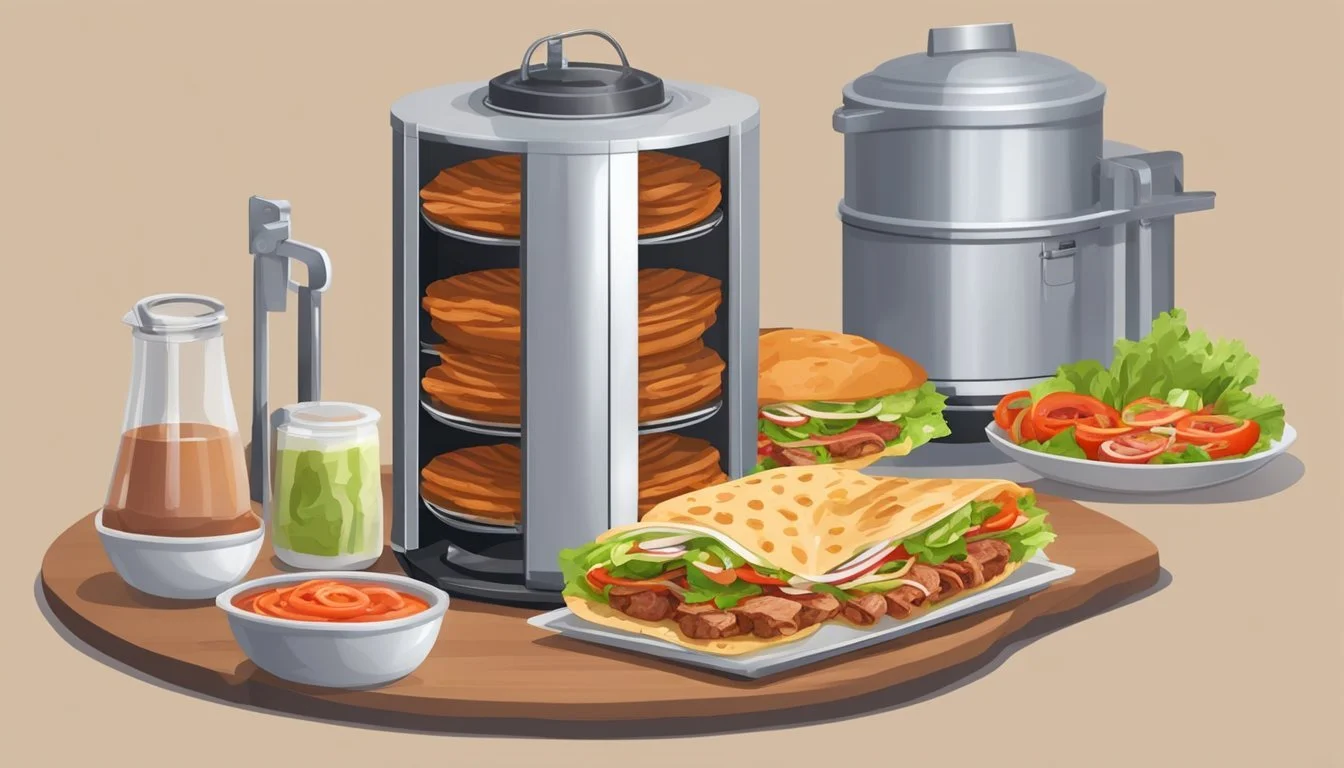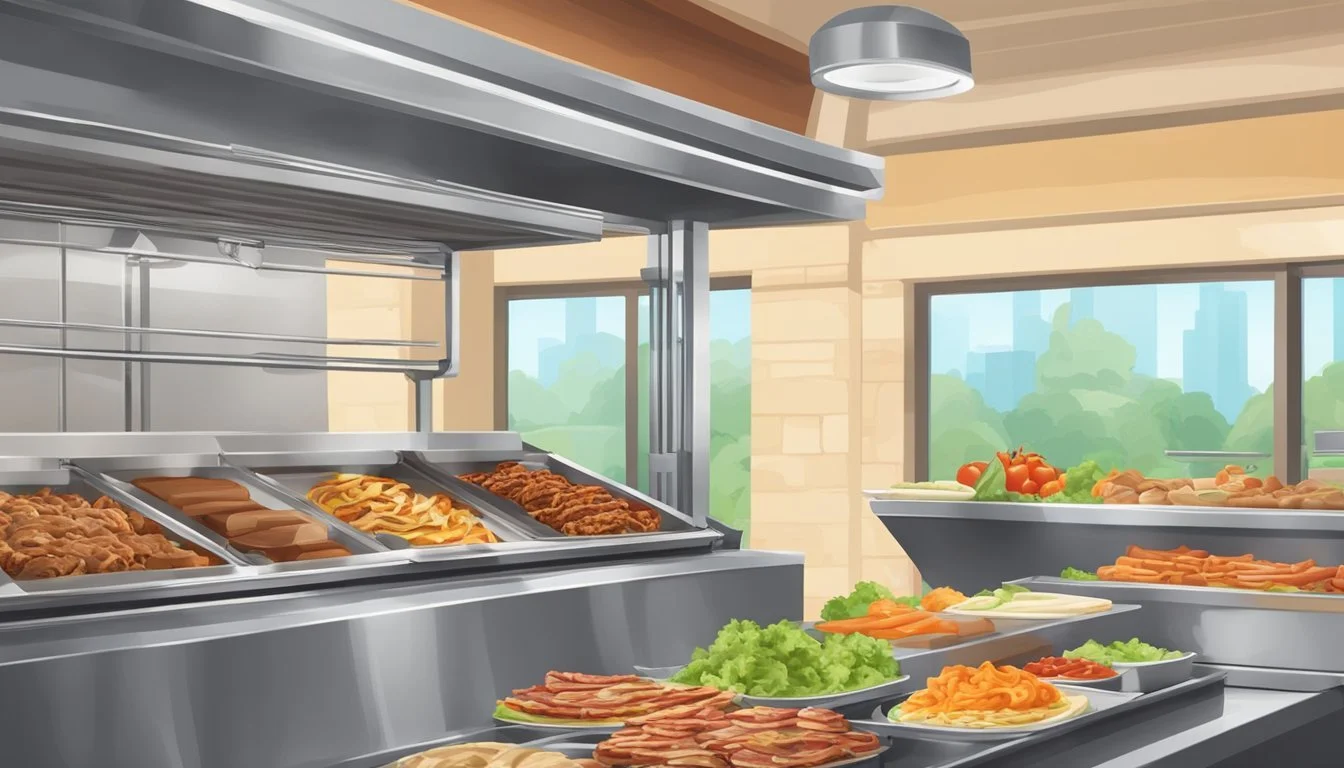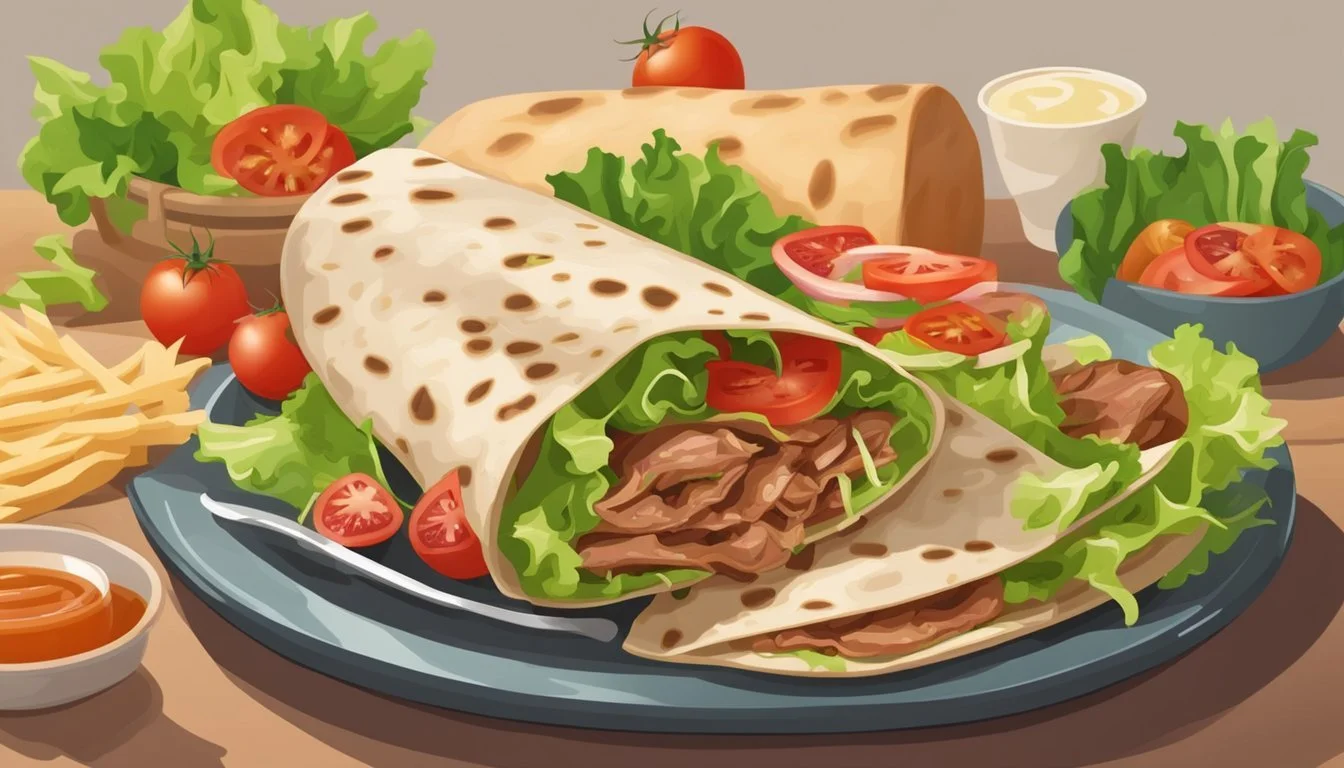How do you eat a doner kebab?
Tips for Enjoying This Popular Street Food
Eating a doner kebab, a popular street food that finds its origins in the Middle East, typically involves a few steps reflecting the dish’s construction and the eater's preferences. A doner kebab consists of meat, often beef, lamb, or chicken, which is seasoned and cooked on a vertical rotisserie. This cooking style allows the meat to baste in its own juices, ensuring tenderness and flavor. The sliced meat is then typically served wrapped in flatbread, such as pita or lavash, with a selection of fresh salad, vegetables, and sauces.
To eat a doner kebab, consumers may unwrap the tightly rolled sandwich partially or keep it fully wrapped, depending on personal preference and the likelihood of the fillings spilling out. The sauce in the kebab, which provides moisture and complementary flavors, can make the wrap soggy if left to sit, so consumption shortly after preparation is ideal. It’s common to eat a doner kebab with one's hands, as it is a casual, easy-to-carry meal, which has contributed to its widespread popularity as a satisfying, savory option on-the-go.
While variations of the dish occur regionally, with different breads, meats, and accompaniments, the essence of the doner kebab remains the same: well-seasoned meat, combined with a balance of tangy sauces and crisp vegetables, all bundled up in an easy-to-consume format. It is this combination that has cemented the doner kebab's status as a beloved option for diners looking for a hearty, quick meal, whether they're on a busy street corner or at a local eatery. Whether it is enjoyed as a quick lunch or as a late-night snack, each bite offers a taste of the culinary practices and traditions of the Middle East adapted for the fast pace of modern life.
Historical Background
Before delving into the culinary specifics of enjoying a döner kebab, it's essential to understand its rich history and how it became a global phenomenon.
Origins of Doner Kebab
The inception of the döner kebab is rooted in Turkish cuisine, often cited as taking place in Turkey during the 19th century. It's believed that in Bursa, Iskender Efendi conceived the idea of roasting meat on a vertical spit in the 1870s. The term döner in Turkish means "to rotate", referring to the meat's continuous rotation next to a heat source, allowing for even cooking and an appetizing char.
Doner Kebab's Global Spread
The pivotal moment for the döner kebab's international journey began in Germany. Specifically, Kadir Nurman, a Turkish guest worker, is often credited with introducing the döner kebab to the German palate in 1972, in Berlin. This adaptation quickly gained popularity among locals and visitors, creating a new culinary staple within the country. The döner kebab's novel taste and quick-serving format suited the fast-paced lifestyle of cities, helping it spread across Europe and eventually, globally.
Ingredients and Variations
Eating a doner kebab involves a delightful combination of savory meats, fresh vegetables, aromatic spices, and hearty bread. The variations in ingredients offer a spectrum of flavors to suit individual preferences.
Meat Selection
Doner kebabs traditionally use meats like lamb, beef, chicken, or turkey. The selection can vary based on regional preferences; for instance, lamb is commonly used in European countries while chicken and turkey are favorites in Middle Eastern regions. The meat is typically marinated, then stacked in a cone-like shape and slowly roasted on a vertical rotisserie.
Vegetables and Accompaniments
To complement the juicy slices of meat, a range of fresh vegetables and accompaniments are added. Common selections include:
Onions (raw or caramelized)
Tomatoes (fresh or grilled)
Red onions
Lettuce
Cucumber
These ingredients offer a crisp contrast to the rich meat, elevating the overall flavor profile of the doner kebab.
Spices and Seasonings
A mix of spices and seasonings is crucial for the distinctive taste of the meat. Main seasonings often include:
Cumin
Smoked paprika
Dried oregano
Salt and black pepper
They give the kebab its aromatic appeal and can be adjusted according to taste.
Bread Options
The foundation of any doner kebab is the bread that holds all components together. Popular options are:
Pita bread, a common choice that's easily stuffed
Flatbread, providing a softer wrap
Wrap-style bread, which may vary regionally
These breads are chosen for their ability to support the weight and moisture of the meat and vegetables without falling apart.
Preparation Techniques
In crafting an authentic doner kebab, meticulous attention to the preparation process is pivotal—from marination to the final cooking stage, each step plays a crucial role in achieving the traditional flavors and textures synonymous with this beloved dish.
Marination Process
The marination of the meat is crucial for infusing depth of flavor. A typical marinade for doner kebab includes a blend of yogurt, garlic, and an array of spices such as cumin, smoked paprika, and coriander. Meat pieces are left to marinate for several hours, or ideally overnight, ensuring that the flavors penetrate thoroughly.
Forming the Meat Stack
Post-marination, the meat is assembled onto a vertical spit—a process that is both an art and a science. Skilled chefs stack the marinated meat, often alternating between different types of meats, to form a cylindrical shape. This stack is then compressed to ensure consistency in cooking and to hold its shape on the rotisserie.
Cooking on a Vertical Spit
The stacked meat is cooked on a rotating vertical spit that turns adjacent to a heat source. The rotation allows for even cooking and a succulent result, as the meat self-bastes while the outer layers develop a delectable crispiness. Once the outer meat is thoroughly cooked, it is shaved off in thin slices, ready to be served.
Alternative Cooking Methods
For those without a vertical spit, alternative cooking methods are available:
Oven: One can place the marinated meat loaf in an oven and roast until a meat thermometer indicates it's thoroughly cooked.
Grill: Meat skewers can be grilled, ensuring they are regularly turned for an even cook.
Pan: For a quicker method, thin slices of marinated meat can be pan-fried, replicating the crispy edges characteristic of a traditional doner kebab.
Each method requires close monitoring to maintain the integrity of the meat's texture and flavor, ensuring a satisfying doner kebab experience.
Assembling the Doner Kebab
Assembling a doner kebab involves careful layering of fresh ingredients and sauces, complemented by proper folding techniques for the perfect handheld meal. Mastery in wrapping ensures a pleasurable and mess-free eating experience.
Layering the Ingredients
The foundation of any good doner kebab is the wrap, typically a warm, soft flatbread such as pita. Onto this base, one spreads a generous layer of sauce—choices can include yogurt, tahini, or hummus—enhanced with olive oil, lemon juice, garlic sauce, tzatziki, or even chilli sauce to lend a juicy quality to the meal. It's crucial to distribute the sauce evenly to ensure every bite is flavorful.
Next, the chef adds the main ingredient, which is commonly thin slices of savory, perfectly cooked meat. This is the stage where the magic happens, as the meat, rich in its own juices, melds with the sauces. For those seeking extra heat or zest, an additional drizzle of sauce can be added atop the meat.
The kebab is then adorned with an array of fresh vegetables such as tomatoes, cucumbers (how long do cucumbers last?), and onions. Finally, one can opt to garnish it with pickles or a sprinkle of spices to taste.
Folding and Serving Techniques
Once the kebab is layered with all its components, the skillful folding comes into play. The proper technique is to fold the sides of the flatbread towards the center, enveloping the fillings, and then roll the wrap tightly to secure everything in place. The goal here is to wrap the contents snugly enough to contain them, yet not so tight as to squash the ingredients.
To serve, the doner kebab is often cut in half to make it easier to handle. If it's to be eaten on the go, wrapping the bottom half in foil is a common practice, providing stability and helping to capture any escaping juices or fillings. When executed well, the assembled doner kebab becomes a satisfying, handheld sandwich that is both delectable and convenient to eat.
Serving and Consumption
When it comes to consuming a doner kebab, it is typically served directly onto a plate, accompanied by various sides and sauces. Each element enhances the overall flavor experience.
Traditional Sides
A doner kebab is commonly paired with a selection of traditional sides that may include salad, rice, and fries. The salad often consists of fresh vegetables such as lettuce, tomatoes, and cucumbers. The rice can serve as a hearty base to complement the savory slices of meat. Fries, either seasoned or plain, add a satisfying crunch.
Salad: Lettuce, tomato, cucumber
Rice: Typically seasoned with herbs and spices
Fries: Offered seasoned or plain
Sauce and Dressing Options
The kebab can be drizzled with a variety of sauces, with yogurt sauce being a popular choice for its cool and creamy texture juxtaposed against the spiced meat. Other sauce options can include spicy sauces, garlic-based sauces, or tahini.
Yogurt Sauce: A cool, creamy accompaniment
Bold spicy sauces: For those seeking heat
Garlic or tahini sauces: Adding depth to the flavors
Eating Etiquette
Consumers should approach eating a doner kebab with an appreciation for the mix of tastes and textures. It is customarily eaten with utensils when served on a plate, though it can also be enjoyed as a wrap for a more casual, handheld option. The presence of sides like hummus or tabbouleh and garnishes such as pickles can be mixed with the meat or eaten separately according to individual preference.
Utensils: Typically used when served on a plate
Handheld: As a wrap for casual consumption
Mixing sides: Such as hummus, with the meat is optional
Dietary Considerations
When indulging in a doner kebab, it is important to consider the nature of its ingredients and preparation techniques to align with one's dietary goals and restrictions. Key considerations include the fat content and the options available for customization to accommodate various dietary needs.
Customizing for Dietary Restrictions
Individuals with dietary restrictions can still enjoy doner kebabs by choosing ingredients that cater to their needs. For example:
Vegetarians may substitute meat with grilled halloumi or falafel.
Those avoiding gluten can opt for gluten-free bread or discard the bread altogether.
People on a low-fat diet might choose lean cuts of meat or increase the proportion of salads.
Healthier Preparation Alternatives
To reduce the fat content and make a doner kebab healthier, consider these preparation alternatives:
Meat: Opt for chicken or turkey as they are leaner protein sources.
Cooking Method: Choose grilling or baking over frying. Baking can be done with minimum added fat, and grilling allows excess fat to drip away.
Oil: When oil is necessary, use a healthier option like olive oil rather than less healthy fats.
Sauces: Replace high-fat sauces such as mayonnaise with yogurt-based sauces, which contain less fat.
Salads: Increase the quantity of salad in your kebab to add nutrients and fiber without significantly increasing calories.
Making Doner Kebab at Home
Creating a flavorful doner kebab at home can be a rewarding experience that involves precise techniques and savvy make-ahead strategies. This section breaks down the process into manageable steps, ensuring delicious results.
Home Cooking Techniques
One begins by preparing the meat, with a choice between beef or lamb. Dexterity is crucial when working to shape the meat into a cohesive block—typically around 20cm/8 inches long. For this, a person's hands are wet with water to prevent sticking, and then the meat is formed into the desired shape.
The cooking technique varies, with options to oven-cook the meat or grill it. To oven-cook, one typically preheats the oven to 200C (392F) and places the meat into an oiled loaf tin, cooking until done. When opting for the grill, one heats the grill to medium-high heat (about 400 degrees F), placing the skewers on the grates, cooking for around 20 minutes, turning halfway through.
Make-Ahead Tips
A person can marinate sliced or ground meat in a mixture of garlic, spices, salt, and pepper, as well as lemon juice and olive oil to enhance flavors. Marinating should last several hours or overnight, allowing the spices to fully permeate the meat.
For convenience, one may cook the doner kebab in advance. After cooking, the meat can be sliced and stored in the refrigerator. Reheat leftovers by stir-frying in a pan to retain the meat's moisture and flavor, which ensures that the homemade doner kebab retains its quality even when enjoyed later.
Cultural Significance
The doner kebab, beyond being a satisfying meal, holds a substantial place in the cultural landscape and is a subject of international culinary exchange. It represents a fusion of traditions and social experiences, deeply ingrained in numerous cultures.
Doner Kebab in Popular Culture
Doner kebab has transcended its Mediterranean origins to become a global symbol of fast, palatable street food. In popular culture, it is often associated with a quick, hearty option especially sought after during late-night outings. Variants such as the shawarma and gyro are visible in films, television shows, and books, reflecting their acceptance and integration into local food scenes outside their regions of origin. These versions each bring a taste of authenticity from the respective cultures, underlining the cross-cultural appeal of the spinning spit-grilled meat.
Social Aspects of Eating Doner Kebab
Eating doner kebab is not only about sating hunger; it's a social catalyst. It commonly brings people together, especially in urban settings where fast-paced lifestyles make it a convenient choice. Sharing a meal of doner kebab, often found at street carts or small eateries, is a communal experience—a moment of respite and enjoyment within busy lives. This aspect has contributed to the establishment of doner kebab as a communal staple, where discussions, laughter, and memories are shared over plates of thinly sliced, succulent meat, fresh vegetables, and tangy sauces, all wrapped up in a warm, toasted flatbread.






